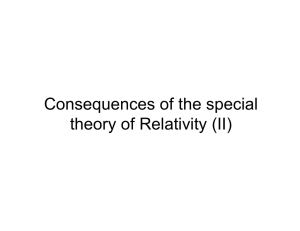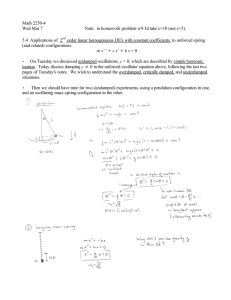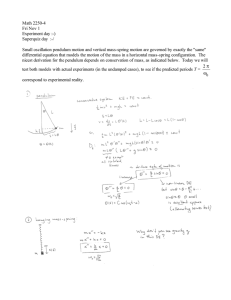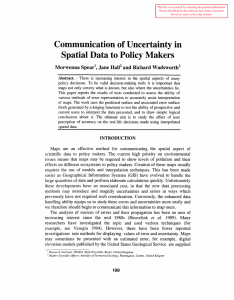11.1
advertisement
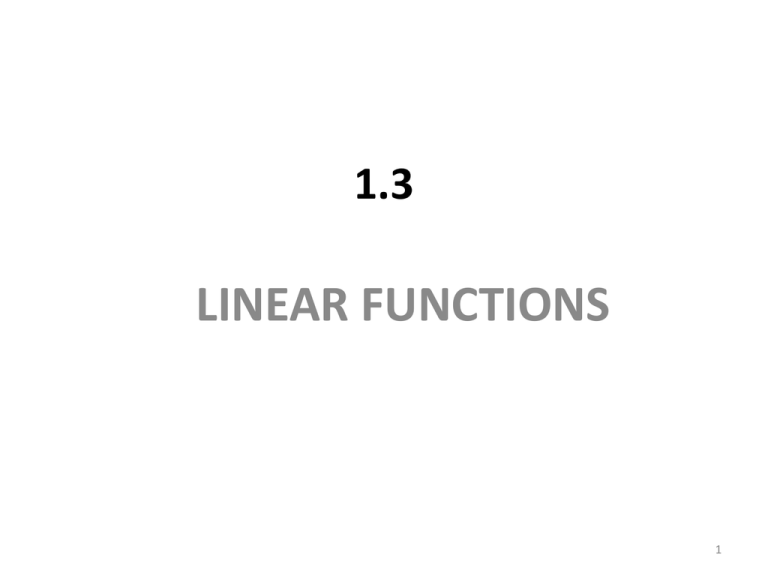
1.3 LINEAR FUNCTIONS 1 Constant Rate of Change • A linear function has a constant rate of change. • The graph of any linear function is a straight line. 2 • Population Growth Mathematical models of population growth are used by city planners to project the growth of towns and states. Biologists model the growth of animal populations and physicians model the spread of an infection in the bloodstream. One possible model, a linear model, assumes that the population changes at the same average rate on every time interval. • Financial Models Economists and accountants use linear functions for straight-line depreciation. For tax purposes, the value of certain equipment is considered to decrease, or depreciate, over time. For example, computer equipment may be state-of-the-art today, but after several years it is outdated. Straightline depreciation assumes that the rate of change of value with respect to time is constant. 3 Constant Rate of Change Population Growth Example 1 A town of 30,000 people grows by 2000 people every year. Since the population, P, is growing at the constant rate of 2000 people per year, P is a linear function of time, t, in years. (a) What is the average rate of change of P over every time interval? (c) Find a formula for P as a function of t. Solution (a) The average rate of change of population with respect to time is 2000 people per year. (c) Population Size = P = Initial population+ Number of new people = 30,000 + 2000 people/year ・ Number of years, so a formula for P in terms of t is P = 30,000 + 2000t. 4 Solution: 5 A General Formula for the Family of Linear Functions If y = f(x) is a linear function, then for some constants b and m: y = mx + b. m is called the slope, and gives the rate of change of y with respect to x. Thus, y m x If (x0, y0) and (x1, y1) are any two distinct points on the graph of f, y y1 y0 then m x x1 x0 b is called the vertical intercept, or y-intercept, and gives the value of y for x = 0. In mathematical models, b typically represents an initial, or starting, value of the output. 6 Tables for Linear Functions A table of values could represent a linear function if the rate of change is constant, for all pairs of points in the table; that is, Change in output Rate of change of linear function Constant Change in input Thus, if the value of x changes by equal steps in a table for a linear function, then the value of y goes up (or down) by equal steps as well. 7 Tables for Linear Functions Example The table gives values of two functions, p and q. Could either of these be linear? x p(x) q(x) 50 5 10 55 15 12 60 25 16 65 35 24 70 45 40 Solution x 50 p(x) 5 Δp 10 55 2 35 10 70 2 25 10 65 2 15 10 60 Δp/Δx 45 2 The value of p(x) goes up by equal steps of 10, so Δp/Δx is a constant. Thus, p could be a linear function. In contrast, the value of q(x) does not go up by equal steps. Thus, q could not be a linear function. x q(x) 50 10 55 60 65 70 Δq Δq/Δx 2 0.4 4 0.8 8 1.6 16 3.2 12 16 24 40 8 9 (a) p 3990 4110 4200 4330 Q(p) 49000 ΔQ ΔQp/Δp -6000 -6000/120 = -50 -4500 -4500/90 = -50 -6500 -6500/130 = -50 43000 38500 32000 (b) The number of Yugos sold decreased by 50 each time the price increased by $1 10 Warning: Not All Graphs That Look Like Lines Represent Linear Functions Graph of P = 100(1.02)t over 5 years: Looks linear but is not Graph of P = 100(1.02)t over 60 years: Not linear Population (predicted) of Mexico: 2000-2005 140 120 100 80 60 40 20 0 P (in millions) P (in millions) Population (predicted) of Mexico: 2000-2005 0 1 2 3 4 5 350 300 250 200 150 100 50 0 0 10 t (years since 2000) 20 30 40 50 60 t (years since 2000) Region of graph on left 11






